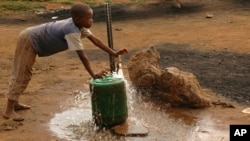GENEVA —
Two leading U.N. agencies are calling for greater action to provide safe drinking water and basic sanitation to more than three billion people. A joint report by the World Health Organization and U.N. Children’s Fund says more must be done to close the gap between the billions who have access to improved water and sanitation and those who do not.
Significant progress has been made since 1990. The United Nations reports almost two billion people now have access to improved sanitation and 2.3 billion people have access to safe drinking water. Of these, 1.6 billion have water piped into their homes.
That is the good news. But the bad news, says Maria Neira, WHO's director of public health, environmental and social determinants of health, is that more than 700 million people still need access to good drinking sources. Half of these people live in Sub-Saharan Africa.
“And, more than one-third of the global population, some 2.5 billion people, they do not use an improved sanitation facility, And, of them, one billion-they still practice open defecation,” she said.
UNICEF is mounting a huge campaign with the government of India called "Take The Poo To The Loo." The cartoon characters prancing about in this video are very amusing. But there is nothing funny about some 600 million people in India defecating out in the open.
UNICEF Senior Statistics and Monitoring Specialist Rolf Luyendijk says a number of governments are making a real push to get the poorest members of their societies to move away from open defecation to fixed-place defecation.
“The way they are doing that is through trying to bring about a change in social norms-that it is socially unacceptable that people practice open defecation," he said. "So, that it is frowned upon …it is making it almost unacceptable in a community to still practice that and that approach has been very successfully used currently in more than 80 countries.”
The report notes poor sanitation and contaminated water are linked to the spread of diseases such as cholera, diarrhea, dysentery, hepatitis A, and typhoid. It notes diarrhea alone is responsible for 842,000 deaths a year due to inadequate water and sanitation.
More than half of the global population lives in cities. The report says urban areas are still better supplied with improved water and sanitation than rural ones. But it notes the gap is closing.
As of now, the report says, 116 countries have met the Millennium Development Goal Target for cutting in half the number of people who lack safe drinking water by 2015. It says 77 countries have met the MDG target for sanitation targets.
Significant progress has been made since 1990. The United Nations reports almost two billion people now have access to improved sanitation and 2.3 billion people have access to safe drinking water. Of these, 1.6 billion have water piped into their homes.
That is the good news. But the bad news, says Maria Neira, WHO's director of public health, environmental and social determinants of health, is that more than 700 million people still need access to good drinking sources. Half of these people live in Sub-Saharan Africa.
“And, more than one-third of the global population, some 2.5 billion people, they do not use an improved sanitation facility, And, of them, one billion-they still practice open defecation,” she said.
UNICEF is mounting a huge campaign with the government of India called "Take The Poo To The Loo." The cartoon characters prancing about in this video are very amusing. But there is nothing funny about some 600 million people in India defecating out in the open.
UNICEF Senior Statistics and Monitoring Specialist Rolf Luyendijk says a number of governments are making a real push to get the poorest members of their societies to move away from open defecation to fixed-place defecation.
“The way they are doing that is through trying to bring about a change in social norms-that it is socially unacceptable that people practice open defecation," he said. "So, that it is frowned upon …it is making it almost unacceptable in a community to still practice that and that approach has been very successfully used currently in more than 80 countries.”
The report notes poor sanitation and contaminated water are linked to the spread of diseases such as cholera, diarrhea, dysentery, hepatitis A, and typhoid. It notes diarrhea alone is responsible for 842,000 deaths a year due to inadequate water and sanitation.
More than half of the global population lives in cities. The report says urban areas are still better supplied with improved water and sanitation than rural ones. But it notes the gap is closing.
As of now, the report says, 116 countries have met the Millennium Development Goal Target for cutting in half the number of people who lack safe drinking water by 2015. It says 77 countries have met the MDG target for sanitation targets.






